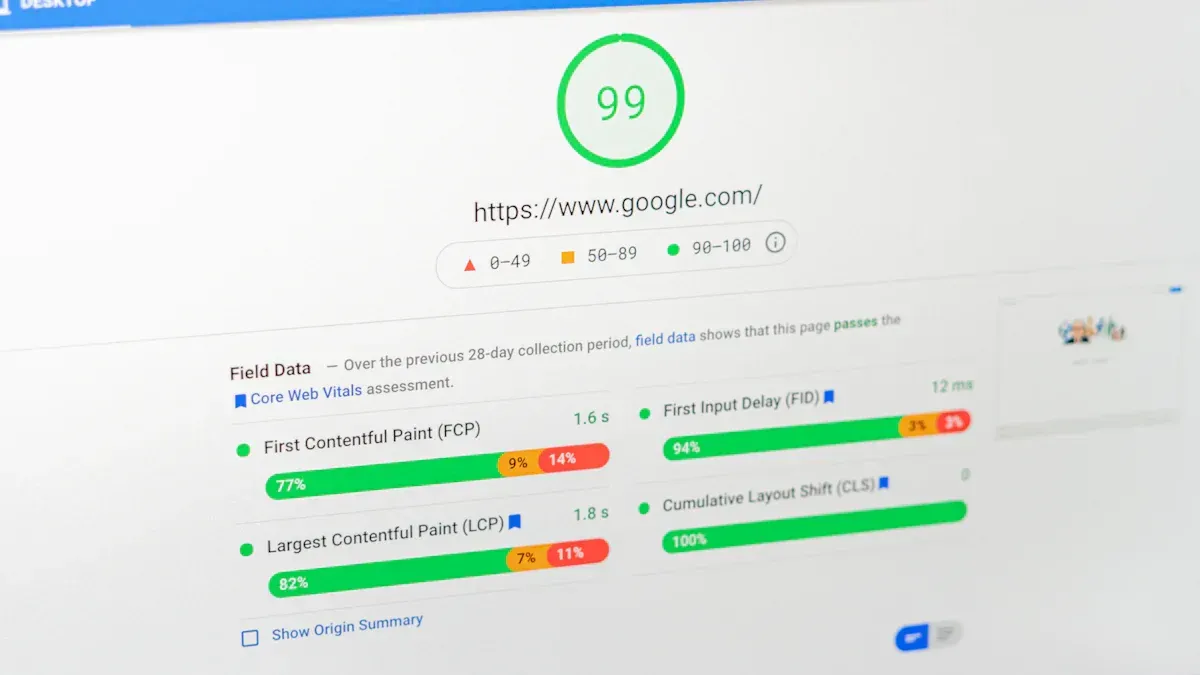Learn How to Perform a Digital Marketing Audit for Maximum Impact

Ever wondered why some businesses thrive online while others struggle? The secret often lies in a comprehensive digital marketing audit. This audit acts as your roadmap, helping you navigate the digital landscape. By evaluating your digital activities, you can uncover hidden opportunities for growth.Regular audits ensure that your marketing efforts remain effective and aligned with your goals. A data-driven approach, using tools like Google Analytics, provides insights into your marketing communications. Start auditing today and unlock the full potential of your digital presence.
Understanding the Basics of a Digital Marketing Audit
What is a Digital Marketing Audit?
Definition and Purpose
A digital marketing audit involves a comprehensive evaluation of your online presence. This audit examines every aspect of your brand’s digital footprint. The goal is to gain a clear understanding of how your digital strategies are performing. Businesses need to ensure that their marketing efforts align with their goals. A Digital Marketing Audit helps identify areas that require improvement. This process ensures that your marketing dollars are well spent.
Key Components
The key components of a Digital Marketing Audit include several elements. First, you need to evaluate your website’s performance. This includes analyzing the user experience and technical aspects. Next, assess your digital channels, including social media, email marketing, and paid advertising. Look at engagement levels and content effectiveness. Content marketing is another crucial area. Check for relevance, consistency, and branding. Finally, review your SEO strategies. Focus on both on-page and off-page factors. These components provide a holistic view of your digital marketing efforts.
Why Conduct a Digital Marketing Audit?
Identifying Strengths and Weaknesses
Conducting a Digital Marketing Audit helps you identify strengths and weaknesses. This process allows you to see what works well in your current strategy and evaluate various digital marketing activities. You can also pinpoint areas that need improvement. By understanding these strengths and weaknesses, you can make informed decisions. This knowledge helps optimize your marketing strategies for better results. Regular audits ensure that your business stays competitive in the fast-changing online space.
Aligning with Business Goals
Aligning your digital marketing efforts with business goals is crucial. A Digital Marketing Audit helps achieve this alignment by informing your digital marketing plan. The audit provides insights into how well your strategies support your objectives. You can adjust your tactics based on these insights. This ensures that your marketing activities contribute to your overall success. Businesses that align their marketing efforts with their goals often see better returns on investment.
Auditing Content Marketing
Evaluating Content Quality
Relevance and Engagement
Content relevance plays a huge role in capturing your audience's attention. You need to ensure that your content addresses the needs and interests of your target audience. Ask yourself: Does the content answer your audience's questions? Engaging content encourages readers to interact, share, and comment. Use storytelling techniques to make your content more relatable. Successful companies often use case studies to uncover actionable insights. These insights help enhance content strategy and boost engagement.
Consistency and Branding
Consistency in content delivery builds trust with your audience. Your brand voice should remain uniform across all platforms. This consistency helps reinforce your brand identity. Regularly publishing content keeps your audience engaged and informed. A well-defined content marketing strategy ensures relevant content throughout the customer journey. This approach assesses the effectiveness of your content marketing strategy.
Analyzing Content Performance
Metrics to Track
Tracking the right metrics is crucial for understanding content performance. Key metrics include page views, time on page, and bounce rate. These metrics provide insights into how users interact with your content. High engagement rates indicate successful content. Low engagement might suggest a need for improvement. Use these metrics to guide your content strategy decisions.
Tools for Analysis
Various tools can help analyze content performance effectively. Google Analytics offers detailed insights into user behavior. Social media platforms provide analytics for engagement and reach. Tools like SEMrush and Ahrefs help assess SEO performance. These tools identify areas where your content excels or needs improvement. Leveraging these tools ensures your content strategy remains data-driven. Additionally, conducting an email marketing audit can help evaluate and optimize your email marketing strategies by reviewing email designs, subscriber metrics, open and click rates, and overall campaign effectiveness.

Social Media Audit
Conducting a social media audit is a crucial step in social media marketing to assess your social media profiles, evaluate performance across different platforms, and integrate insights into broader marketing strategies.
Assessing Social Media Presence
Platform Performance
Ever wondered how your social media platforms are performing? A social media marketing audit provides a clear picture. Start by gathering data on each platform. Look at metrics like follower growth and posting frequency. Compare your performance with industry competitors. This comparison helps identify where you stand. Use tools like Google Analytics for deeper insights. These insights reveal the effectiveness of your marketing communications.
Audience Engagement
Audience engagement is key to social media success. Review the engagement rate of recent posts. Check likes, shares, and comments across platforms. Notice any patterns? Some content types may perform better on certain platforms. Videos might get more likes on Facebook. Photos could do well on Instagram. Understanding these trends helps tailor your content strategy. A data-driven approach ensures your efforts resonate with your audience.
Optimizing Social Media Strategy
Content Strategy
A strong content strategy drives social media success. Evaluate the quality and relevance of your content. Does your content address audience needs? Engaging content encourages interaction and sharing. Consider using storytelling techniques. Stories make content relatable and memorable. Regularly update your strategy based on performance data. This keeps your content fresh and engaging.
Scheduling and Frequency
Timing matters in social media. Analyze your posting schedule. Are you posting at optimal times? Frequency affects audience engagement. Too many posts can overwhelm followers. Too few might lead to disengagement. Find the right balance for your audience. Use scheduling tools to plan posts in advance. Consistent posting builds a loyal following. Adjust your schedule based on engagement metrics for maximum impact.
SEO Audit
On-Page SEO Analysis
Keyword Optimization
Keyword optimization stands as a cornerstone of on-page SEO. You need to ensure that your website targetseffective keywords. These keywords should align with what users search for. Use tools like Google Keyword Planner to discover relevant keywords. Place these keywords strategically in your content. Keywords should appear in headings, subheadings, and throughout the text. This practice helps search engines understand your content’s focus. A well-optimized page can improve search rankings. Additionally, conducting a technical SEO audit is crucial to evaluate the specific technical elements of your website that affect its search engine performance.
Meta Tags and Descriptions
Meta tags and descriptions play a crucial role in on-page SEO. These elements provide search engines with information about your page. Craft compelling meta descriptions to attract clicks from search results. Include primary keywords in both meta tags and descriptions. Keep meta descriptions concise and informative. A good meta description can increase click-through rates. Search engines often use these descriptions in search results. This visibility can drive more traffic to your site.
Off-Page SEO Evaluation
Backlink Profile
A strong backlink profile enhances your site's authority. Backlinks act as endorsements from other websites. Quality matters more than quantity in backlinks. Seek links from reputable and relevant sites. Tools like Ahrefs can help analyze your backlink profile. Identify any low-quality or spammy links. Removing harmful links can protect your site's reputation. Building a solid backlink profile boosts search engine rankings.
Domain Authority
Domain authority reflects your site's credibility. High domain authority often leads to better rankings. Moz provides a tool to check your domain authority score. Focus on improving your site's content and backlink profile. Engaging content attracts more visitors and backlinks. Consistent efforts can gradually increase domain authority. A high domain authority signals trustworthiness to search engines. This trust can enhance your site's visibility in search results.

Website Performance Audit
Technical Performance
Page Load Speed
Page load speed plays a big role in user satisfaction. Slow websites frustrate visitors. Users expect quick access to information. Fast-loading pages improve user experience. Search engines favor speedy sites. Use tools like Google PageSpeed Insights. Identify areas for improvement. Optimize images and reduce server response time. A faster site keeps users engaged.
Mobile Responsiveness
Mobile responsiveness matters more than ever. Many users browse on mobile devices. Websites must adapt to different screen sizes. A responsive design ensures accessibility. Test your site on various devices. Check for layout issues or broken elements. Google’s Mobile-Friendly Test can help. A mobile-friendly site attracts more visitors.
User Experience
Navigation and Usability
Easy navigation enhances user experience. Visitors need to find information quickly. Clear menus and logical structure guide users. Avoid cluttered designs. Use descriptive labels for links. Test the site’s usability with real users. Gather feedback to make improvements. A user-friendly site encourages exploration.
Conversion Rate Optimization
Conversion rate optimization boosts business success. Analyze user behavior on your site. Identify barriers to conversion. Simplify the checkout process. Use clear calls-to-action. Test different layouts and content. Tools like Hotjar provide insights. Track changes and measure results. Higher conversion rates lead to more sales.
Integrating Audit Findings into Strategic Planning
Developing an Action Plan
Prioritizing Changes
You’ve gathered all the data from your digital marketing audit. Now, what’s next? Prioritizing changes becomes crucial. Not every issue needs immediate attention. Focus on areas with the most impact on your goals. High-impact changes should take precedence. These might include improving website speed or enhancing content quality. A clear priority list helps manage resources effectively. You’ll see better results by tackling the most critical issues first.
Setting Measurable Goals
Setting measurable goals keeps your strategy on track. Clear goals provide direction and motivation. Use specific metrics to define success. For example, aim to increase website traffic by 20% in three months. Measurable goals allow you to track progress easily. Regularly review these goals to ensure alignment with business objectives. Adjust them as needed to stay relevant. Achieving these goals will boost your digital marketing efforts.
Implementing and Monitoring Changes
Tracking Progress
Tracking progress ensures your action plan stays effective. Use analytics tools to monitor key performance indicators (KPIs). Regularly check metrics like conversion rates and engagement levels. Tracking helps identify successful strategies. You’ll also spot areas needing improvement. Consistent monitoring keeps your marketing efforts aligned with your goals. Celebrate small wins along the way. These victories motivate your team to keep pushing forward.
Adjusting Strategies as Needed
Adjusting digital marketing strategies maintains your competitive edge. The digital landscape constantly evolves. Stay flexible and ready to adapt. Use insights from tracking progress to refine your approach. If a tactic isn’t working, try something new. Experimentation leads to innovation. Regular adjustments ensure your strategy remains effective. Embrace change as an opportunity for growth. Your business will thrive by staying ahead of the curve.
A digital marketing audit offers a comprehensive evaluation of your online presence. This process uncovers strengths and weaknesses in your strategies. Regular audits ensure your marketing efforts stay effective. Businesses that perform ongoing audits remain competitive. You should take action based on insights gained from the audit. Implement changes to enhance your digital marketing strategy. Your business will thrive with a proactive approach. Embrace the audit process to unlock growth opportunities.

